I really wanted to hike the Nakasendō, a 534-kilometre ancient highway between Kyoto and Edo (Tokyo). It was a romantic notion. I knew little about it, but I loved the idea of it. Some parts of it existed as early as the 7th century. Under the Tokugawa Shogunate, in the 17th century, the smaller pathways between villages were all linked together to establish a highway with 69 staging posts. It was one of several established by the Shogunate as a communications network that was needed to rule the country.
Naively I imagined it to be a rural pathway through the mountains, which no doubt it once was. It does still exist, roughly following modern roads, so in reality walking the Nakasendō would be a long walk through industrialised Japan; so not that romantic after all. Then when we were in Kyoto in March of last year I learned that it’s possible to do a day trip from Kyoto to walk the most interesting section of it, the largely rural 8-kilometre stretch between the preserved staging-post villages of Tsumago and Magome. It sounded perfect. I didn’t have to walk the whole distance, just a little bit to get something of the experience of it. And I kind of convinced Don that we should do it on one of our days in Kyoto. Until we looked into the details.
It would have meant leaving our Airbnb at 6.30 in the morning followed by a journey of about five hours that included the subway, two trains and a bus, just to get to the start of it. Then about three hours for a very leisurely hike, and then an equally long return journey. So I somewhat reluctantly let go of the idea and, as Don suggested, looked for something more local. Looking back now at the photos online of the Tsumago-Magome section of the Nakasendō it doesn’t look any more interesting than the hike we do – the hike over Mt Kurama between the villages of Kurama and Kibune.
We take a train from Demachiyanagi Station
through metropolitan Kyoto
straight north towards the mountains. After an easy 45-minute journey the first thing we see when we leave the station is this.
It’s a Tengu. Tengu are superheroes! They can fly; they have great physical strength, martial arts skills, and magical powers. But you’d better be paying attention because they are shape-shifting sorcerers as likely to possess you as help you. Everything abnormal and mysterious is attributed to them, which in turn gives them even more power.
I look at it and think it’s just another funny Japanese mythical creature, unimposing and not particularly attractive with its strange long red nose, but these mischief-makers, these legendary creatures of Japanese folk religion, are deeply embedded in the culture.
They are sometimes described as forest goblins, and are believed to be the guardians of the mountains. Also this: they mislead the pious with fake images of the Buddha; they carry monks off and drop them in remote places; they possess women and speak through their mouths in an attempt to seduce holy men (yeah, the patriarchal nature of this, and the denigration of women in the ethos of the community is not lost on me, but at least these “wayward” women can blame a Tengu); they rob temples; they are the ghosts of angry or vain priests; they can control the wind; they abduct people to torment them, or perhaps to teach them magic, which never turns out well; they appear uninvited in people’s dreams; those who worship them are given ungodly powers, much like the devil I guess.
And so they are treated with much caution and respect. You really don’t want to mess with a Tengu. They are as equally revered in Shinto as in Buddhism, and are often the guardians of Buddhist temples.
So the beginning of our hike, which takes us up the mountain to Kurama-dera Temple, is a kind of warning. Here stands the temple guard and it is not to be taken lightly, but knowing nothing about it at the time I’m puzzled and amused rather than wary.
A short walk brings us to Kurama-dera Temple’s Main gate
The legend is that in 770, a Chinese monk had a dream to go north from Nara, where he lived, to Mount Kurama because it held spiritual power. He got lost along the way but another dream saved him. He followed what he saw in this dream and came to a white horse that led him to Mt Kurama, or Horsesaddle Mountain. But before he could establish the temple he had to ward off demons that wanted to eat him. It’s always something isn’t it? Probably those wicked Tengu were at it again, but the monk prevailed.
Later a noble from Kyoto sponsored the construction of a proper temple complex on the mountain, which constitutes much of present day Kurama-dera Temple. But as we discover it is not simply one temple complex at the top of the mountain but a whole series of altars and places of worship that punctuate our hike on the way up.
Bit by bit as we climb we are treated to little morsels of loveliness, encouraging us to climb further.

And in between all these places of worship there are stairs, always more stairs,

The trail leads us to an enormous wooden structure
and so we mount the stairs and pass through the tunnel. It is the gate to Yuki-jinja Shrine,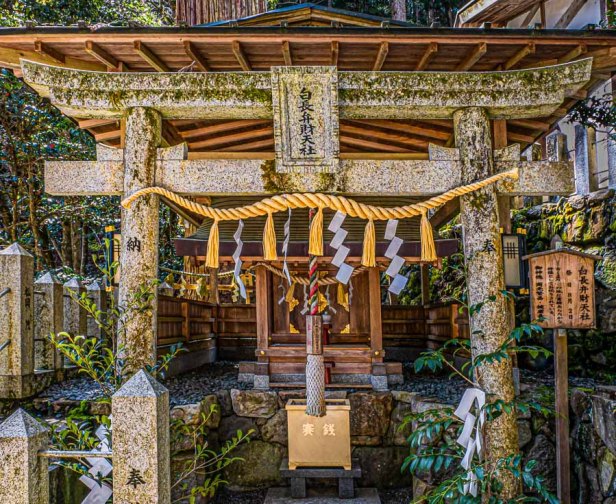

which was moved from downtown Kyoto in 970 to protect the area from evil. A giant sacred pine tree that is said to be 800 years old stands sentinel, revered custodian of the shrine.
Moving on we come to a bridge,
and follow the path ever upwards through the forest.

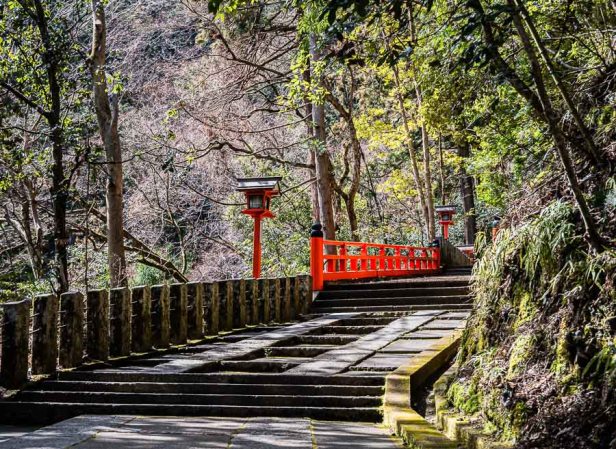

It’s a beautiful day, and at every turn we are enchanted, wondering what loveliness the path will present to us next. Another small altar,
a bigger shrine,
and the striking dragon fountain of the chozuya for ceremonial purification at the Tenborindo Buddhist Temple
Now we’re high enough for the views

enhanced by hints of spring blossoming to come.
We continue climbing
until at last we are at the top of the mountain, standing in a graceful spacious plaza with the main hall of the temple on one side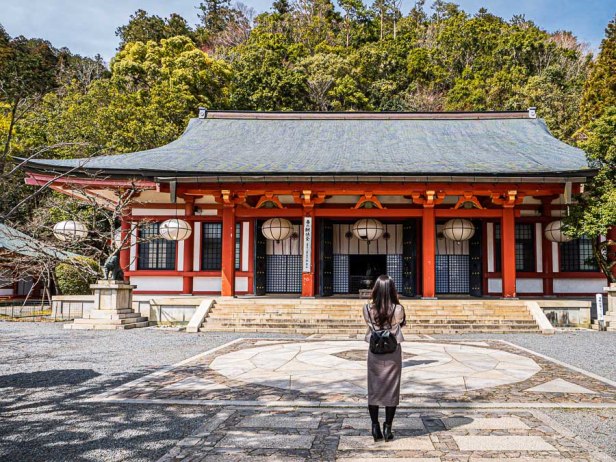
and a lovely view on the other.

For over a thousand years this has been known as a spiritual power spot, a holy place, for devotees of both Shinto and Buddhism. In front of the woman praying is a pattern, a mandala, in the pavement. It is known as one of Japan’s most famous power spots. The six points of the mandala correspond to the six ways humans connect with the world: eyes, ears, nose, mouth, body, and heart.
The temple is guarded by a pair of fantastical tiger statues standing strong and proud on either side of the main hall. Don’t mess with me they seem to say.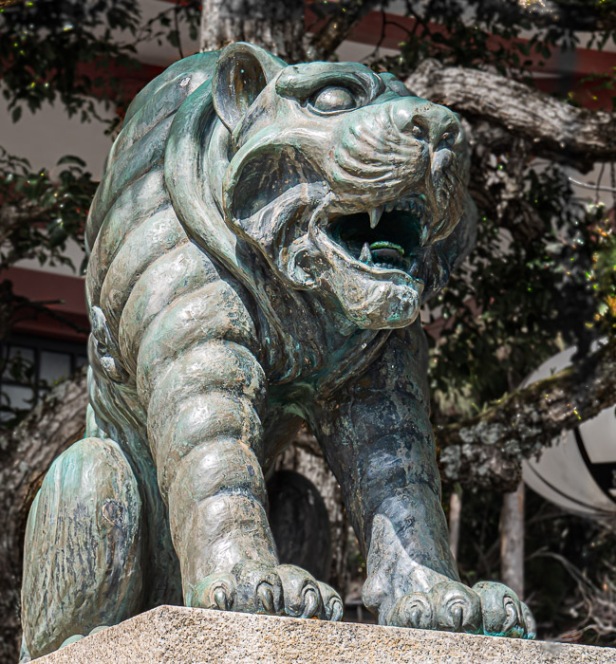
After a break we continue on, passing another small temple
and soon find ourselves on a path bursting with tree roots.
It is unexpected. And lovely. They are the roots of Japanese cedars. This mountain is full of mysterious tales and legends; things have to be explained somehow. One story has it that when he was a boy a famous warlord trained here at night with the Lord of the Tengu. I wonder what powers he gained having his own private wizard to coach him here in the deep dark shadows of the cedars.
Here also there is a constant breeze blowing up from the hills below. It is a place that makes me happy, being surrounded only by nature.
The path continues through the forest as we begin our descent

And here’s another fantastical tale. What we come to next is a shrine known as Oku-no-in Mao Den.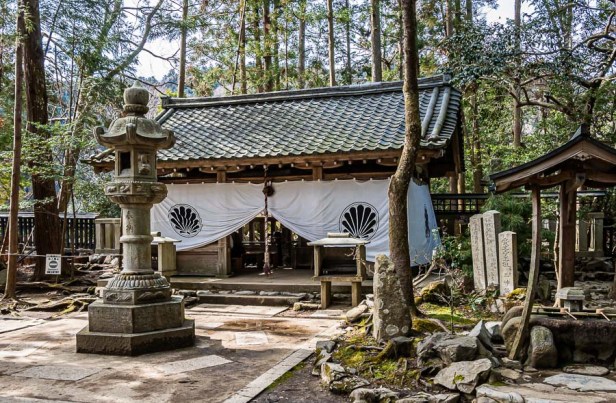
It is the shrine of Mao-son, the god of the mountain! It is said that six million years ago he descended to earth in a divine carriage of the Prince of Flames when a meteorite from Venus streaked across the sky and landed here in this spot. It is enshrined as the kami, or Shinto god, known as Mao-son, the great King of the Conquerors of Evil and the Spirit of the Earth. Ever since his powerful energy has been emanating from Mt Kurama overseeing the development and evolution of all living beings.
The path leads us ever onward through the forest.
We are descending now on rough stairs until finally we reach the road and the very small village of Kibune snug in the forest next to the Kibune River. The village exists because of the shrine, which exists because a goddess travelled by boat from Osaka all the way up river into the mountains. The shrine was built where her journey came to an end. There is a long lanterned-lined staircase up to the Kifune Shrine, dedicated to the god of water and rain, and where the goddess’ yellow boat is said to be buried.

Everything about this mountain is held sacred, from the many altars, shrines, and subtemples along the trail, to the paved mandala at the top, to the green shimmering forest, and the distant luring views. Everything on the path is honoured by both of Japan’s religions. It is a much-revered place, held in a transcendent sacred crucible, and many pilgrims come to absorb the energy and to pray here.
This easy four-kilometre hike proved to be the perfect combination of nature and culture, and although we didn’t know the significance of all the places we were passing, the beauty, and the unexpectedness of what would be next was enough to lead us on; that, and the forest and the fresh air, and the earth beneath our feet and the blue sky above. We walk the two kilometres down the road to Kibune-guchi Station and take the train back to Demachiyanagi Station in Kyoto, and then the subway back home. It’s been a beautiful day.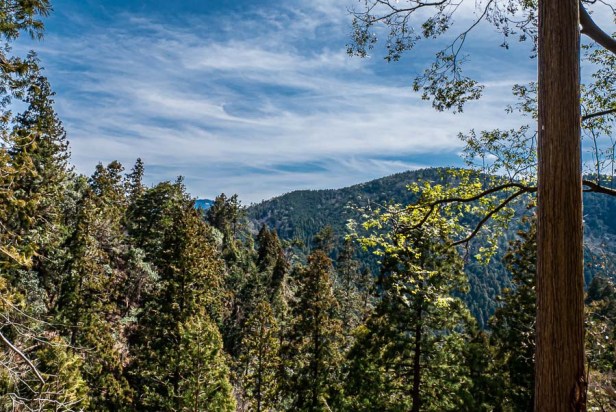
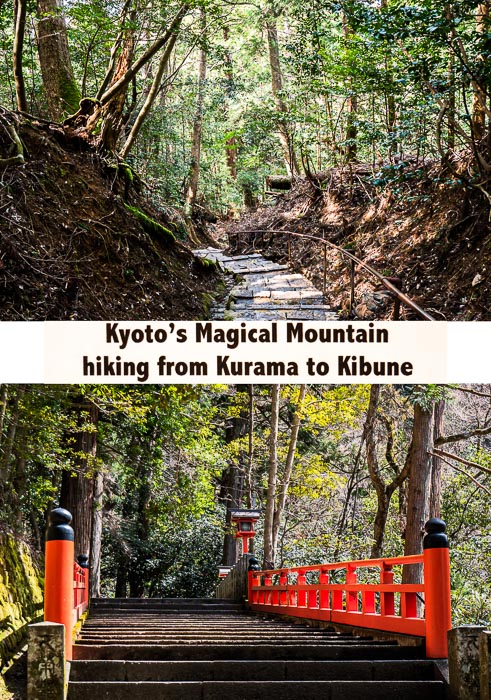
All words and images by Alison Louise Armstrong unless otherwise noted
© Alison Louise Armstrong and Adventures in Wonderland – a pilgrimage of the heart, 2010-2020.


What a lovely journey into nature and mysticism. You guys are awesome…..Not sure I could climb those stairs that far, so thanks for sharing so I can at least do that virtually.
LikeLiked by 1 person
Thanks so much Eileen. It was a really lovely way to spend a day outside of the city. Glad you followed along!
Alison
LikeLike
So often it happens that the alternate plan is better than the original one. This looks like an amazing day.
LikeLiked by 1 person
It was a really wonderful day, and for sure at least as good as the original plan, if not better. Anyway it worked out well and for sure it turned out to be a good choice.
Alison
LikeLiked by 1 person
So very beautifully… Japanese 🙂 🙂 All those steps must have a purpose. A shame to come back down to earth.
LikeLiked by 1 person
Oh yes, so Japanese! So lovely. And all the climbing was definitely worth it.
Alison
LikeLiked by 1 person
Everything is so neat, a perfect illustration of Japanese perfection. A pleasure for the eyes.
LikeLiked by 1 person
I love the neatness of Japan. The whole hike was a pleasure. They take care of everything with such meticulous detail, and it was lovely to be out of the city.
Alison
LikeLiked by 1 person
A beautiful mountain! I notice the emblem of the Japanese royal family on one of these altars. Even in Koyasan, you don’t see such a thing. So I guess this place must be very sacred. Thanks for sharing, Alison 🙂
LikeLiked by 1 person
My pleasure Len. Wow, the emblem of the royal family. So I guess this place must be really special. We had no idea of course so thanks for sharing that little bit of info. We really enjoyed the whole hike.
Alison
LikeLiked by 1 person
Beautiful descriptions
LikeLiked by 1 person
Thank you so much xo
Alison
LikeLike
👍
LikeLiked by 1 person
Beautiful post, Alison 🙂
The hiking trail looks so beautiful with well maintained pathways.
A good example of how to maintain tourism attractions which are in pristine landscape.
Thank you for sharing the beautiful images and interesting notes 🙂
Have a great day …
LikeLiked by 1 person
Thanks so much Sreejith. My pleasure. It was a lovely trail that’s for sure. The Japanese maintain everything so well. It’s in their DNA I think. It turned out to be a good choice for us that’s for sure.
Alison
LikeLiked by 1 person
Its a pity we stopped worshipping nature and natural places in western culture. I think the world would be a better place if we still held natural beauty in awe. One of the things I loved about Japan was the little shrines tucked into unexpected places. I didn’t notice so many on a later trip as on my first, but they were still lovely surprises. Thanks for the article.
LikeLiked by 1 person
I so agree about worshipping nature. I am in awe of it all the time, but many don’t even notice it, and of course the profit-driven rape of the planet comes from a lack of connection to the natural world. So heartbreaking. I love Japan, pretty much everything about it. I’ve been twice now, and would love to go back to some of the wild places in the north. One day hopefully . . . .
Alison
LikeLike
What a delightful little stroll. I’ve also had to give up on original day trip plans because of very inconvenient transport and hours. Sometimes it’s just not worth the hassle. I absolutely love the “path of the roots”. So beautiful.
LikeLiked by 1 person
It was the perfect little stroll for our needs. The path of roots was a highlight for sure, but much of the trail was really lovely. We didn’t know what to expect, that there would be so many places of worship, but it’s like any place that’s been held sacred for thousands of years – everyone sets up shop there. It’s the same at Emei Shan in China (what a spectacular place that is!) and at the foot of Mt Fuji.
It turned out to be a good choice for us. I doubt the effort/reward ratio would have been good had we gone to the Nakasendō.
Alison
LikeLiked by 1 person
Such an amazing place to visit, thank you for the tour Alison,
take care,
Christie
LikeLiked by 1 person
My pleasure Christie. It really was a wonderful place. I’m glad we went there.
You too – take care.
Alison
LikeLiked by 1 person
Amazing and right up my alley. It’s been 15 years since I was in Japan, and that was before I became an avid hiker. I really want to do this now…and come back to Japan to enjoy it again. Such a remarkable country.
LikeLiked by 1 person
Thanks Laureen. It was such a lovely hike. I hope you get back to Japan one day. We love Japan and would go back in a heartbeat. I agree – a remarkable country.
Alison
LikeLike
Wow, did you count the stairs? Hundreds and hundreds more. What a lovely and very cultured walk in the forest. Thank you for narrating.
I’m wondering if you are receiving my “likes?” When I click on the star an empty window opens briefly and disappears, the star doesn’t change colour or to “liked” – any suggestions? And I am logged in…
xox
Surati
LikeLiked by 1 person
My pleasure! It was a really sweet hike. Nothing epic, but lots to see, and yeah, plenty of stairs. No we didn’t count them, and there were a lot more than seen in these photos.
I’m not receiving your likes. I’ve had the same thing happen in the past. Sometimes WP just goes poopy, and you just have to wait it out until it rights itself again. One time I couldn’t like any post or comment but could like them all in the WP Reader. Then it fixed itself. The only thing I can recommend is the usual clearing history/cache/cookies and/or logging out of WP and back in again.
Alison
LikeLiked by 1 person
And I missed this one too! Just found it in my “Unread” tab. Still learning the ropes of WP.
Thank you! xo
LikeLiked by 1 person
This brings back so many memories! Japan was my first international trip – it was for business so sadly I didn’t have too much time to explore. We went to Kyoto for our ONE day we didn’t have to work out of 2 weeks – and I remember taking a bunch of old men (their words, not mine 😉 ) up this mountain – and the whole time they’re asking how I talked them into it haha It’s such a beautiful hike.
LikeLiked by 1 person
Wow that’s amazing – you had one day in Kyoto and you chose to hike Mt Kurama! Good choice! We really enjoyed it. I agree – such a beautiful hike. Glad I brought back some good memories for you.
Alison
LikeLike
What a lovely hike. Japan looks like beautiful country!
LikeLiked by 1 person
It was a really lovely hike. I’m glad we did it. Japan is one of my two favourite countries. The other is India! You couldn’t get two more opposite places, but I love them both.
Alison
LikeLike
Such a wonderful post! I found you brace for wanting to do such a long hike and also reminded of the film Spirited Away. I loved Japan and you also brought back beautiful memories!
LikeLiked by 1 person
Thanks so much Heather. Don and I always look for day hikes wherever we are. We did so many in New Zealand! I’ve not seen Spirited Away, but a quick google search tells me I’d love to. I hope I can find it somewhere.
I too love Japan. One of my fave countries.
Alison
LikeLiked by 1 person
If you have Netflix you can find Spirited Away there!!!
LikeLiked by 1 person
Yay! I’ll add it to my watch list. Thanks.
A.
LikeLiked by 1 person
Kurama-dera temple compound seems like a series of beautiful structures with an unmistakably Japanese charm and aesthetics set against a calming landscape. Is going up those stairs the only way to reach the temple on top of the mountain? If so, that chicly dressed up woman in high heels certainly is a role model for hiking with style! I very much adore this trek just by reading your story and looking at your photos — nature meets culture, what could be better?
LikeLiked by 1 person
Thanks Bama. It’s a great trek; so much to take in! I suspect there must be another way up. Certainly from where we started there is a cable car that takes you part of the way though we chose to walk. Or you can get a train followed by a 10 minute walk. I imagine the woman at the temple came that way.
Alison
LikeLiked by 1 person
Alison – This beauty of a walk surely made up for the disappointment of missing out on the long trail. I loved the orange-red-saffron that accented the natural settings. Hurrah for a great adventure. Cheers – Susan
LikeLiked by 1 person
Thanks Susan. This walk definitely made up for missing the Nakasendō. We really enjoyed it.
Alison
LikeLiked by 1 person
As much as I enjoy our deep forest hikes here on the North Shore, I would so welcome a hike like this with nature, views and history/culture all wrapped up in a beautiful package. Those pops of red on the shrines, fences, etc are so eye catching. I’m glad the Tengu left you in peace!
LikeLiked by 1 person
I too love wilderness hikes, and loved the parts of this trail that were more wild, but everything we encountered was a surprise. We never knew what was coming next. It was so Japanese, so beautifully cared for and revered. And yes, those mischievous Tengu behaved themselves for us 🙂
Alison
LikeLiked by 1 person
One short phrase in your story jumped out at me: “wondering what loveliness the path will present to us next.” I’ve never been to Japan, but I imagine that is how I would feel about the whole country and culture! What a beautiful little walk; finding it and making it work for you was a gift.
LikeLiked by 1 person
Japan is absolutely one of our most favourite countries, and I really hope you get there one day. And yes, the whole country is one lovely surprise after another.
This hike was a little gem.
Alison
LikeLiked by 1 person
Some of my favorite memories are the “well, plan A didn’t work out, so on to plan B.” There’s something particularly enchanting when you don’t know exactly what to expect. What a delightful walk!
LikeLiked by 1 person
It *was* a delightful walk. I think in the end it really was the best choice. All the travel just to get to the Nakasendō sounded really daunting. We’ve also had some plan B’s that produced some really lovely surprises. It’s part of the fun of travel isn’t it.
Alison
LikeLike
You describe this mystical pilgrimage perfectly. What an incredible series of photos, you bring us right to this sacred mountain, its altars, shrines, and temples. It is special how all of these pieces of culture are found along the trail within the forest ~ and I admire the flexibility and openness you have when taking such adventures 🙂
LikeLiked by 2 people
Thanks you so much Dalo. It was a really lovely hike, and I’m so glad we chose it. Even though we’d read about it online before we went we were not expecting so much cultural beauty. It’s as if we walked into an entire mountain of Buddhist and Shinto magic. Every little place had a story behind it, every historical event sacred. Definitely worth the climb!
Alison
LikeLike
Quite a leg day, huh?
I for a moment thought you guys did the Magome-Tsumago trail, it’s something I’d love to do one day.
I don’t know about you, but I find Japanese suburbia tremendously fascinating (fact is, I find most suburbia fascinating). I’ve “seen” it so many times in cartoons that every time I happen to find myself there I can’t stop just walking around.
Love Don’s trousers! Bright burgundy identify him as a Torino Football Club fan, even if he doesn’t know it… deep, deep down in his psyche he is!
LikeLiked by 1 person
Oh it was a hike alright. But we’ve done “worse” and it was a beautiful day and we had lots of time. I too would still like to do the Magome-Tsumago trail one day, but it’s not as high on the list as it once was.
I’ve spent quite a few days over two visits to Japan wandering suburbia – I always enjoy it, and like you anywhere really. It’s like getting a sneak peak into another world.
Deep down in his psyche Don’s never heard of the Torino Football Club tho we have been to Torino as the jumping off point for a visit to Damanhur:
Have you been? If not you must go next time you’re back in Italy, if only to see the temples. They are truly extraordinary even if you’re not remotely spiritual.
As for Don’s trousers they are his longjohns lol, showing after he unzipped the bottom half of his pant legs.
Alison
LikeLiked by 1 person
Yeah I went there on a school trip with the nuns!!!! 😆😀 Don doesn’t know but deep deep down he is a Granata supporter. Good taste and all.
LikeLiked by 1 person
With the nuns! 😂 OMG what did they think of it?
Okay, Granada it is 🙂
LikeLiked by 1 person
They found it, shall we say, quite “groovy”.
LikeLiked by 1 person
I mean Granata. F’ing autocorrect
LikeLiked by 1 person
Hi Alison, its been a long while! I hope you still remember me. I was just going through my old blogger friends and came back to your blog. Good to see that you are still actively blogging.
This pilgrimage was an interesting read. I got excited reading the initial paragraph and was thinking of planning a trip to this pilgrimage some time in the future. I love a great pilgrimage route. But soon realised that they are not as romantic as you and I initially imagined from the concept of the pilgrimage route.
Also, from where I am coming from, we also have very similar stories like Tengu. In Kerala, I think they are known as Odiyans. They can shape shift and do a lot of nasty things.
Great to read your Kyoto story and to connect again.
LikeLiked by 1 person
Of course I remember you Jithin! Oh yes, I’m still blogging. I think I’m addicted 🙂 It seems I always have more stories to tell.
This was a good hike. Most hikes in Japan are like this unless you get way out into the wilderness areas.
Odiyans sound interesting. And I’d love to get to Kerala one day. The furthest south I’ve been is Tamil Nadhu, but I’ve heard such good things about Kerala. One day I’ll get there.
Stay safe. I’ve heard the pandemic is pretty bad in India.
Good to connect again!
Alison
LikeLiked by 1 person
Glad to know that you still remember me and active on blogging world.
If you’ve been to Tamil Nadu, you were so close to Kerala! Hopefully some time soon you get to visit Kerala. And yes, COVID situation isn’t that great here. Well, with the kind of population India has, one can imagine the situation. Where are you spending your time now?
LikeLiked by 1 person
We’ve been based back in Canada (Vancouver) for 3.5 years now, travelling about 3 months per year. This year we were in Rishikesh and Malaysia for a bit over 5 weeks and just made it back to Canada before things started shutting down in March. And of course our usual summer travels didn’t happen this year. Hopefully next year!
Alison
LikeLiked by 1 person
Yes, I remember your plans to visit Rishikesh. I think we had a brief chat on Instagram. Glad you got back home before things shut down.
LikeLiked by 1 person
What an incredible spot, Alison. Looks like you got your exercise in. 🙂 Great photos of your adventure. The temples and gates are mystical and magical. Thanks for taking me there.
LikeLiked by 1 person
Thanks so much Jane. Oh yes – plenty of exercise that day! And so much to see. It was really lovely.
Alison
LikeLiked by 1 person
This post brought back such wonderful memories of Nara… we snuck in our trip in December of last year, whew, just in time before COVID!! Beautiful. Love the photo of the cedar roots amongst many other lovelies.
Peta
LikeLiked by 1 person
Thanks so much Peta. I too loved the cedar roots. It was one of my fave parts of the hike. We did a day trip to Nara on this same trip to Japan. I’ll post about it eventually. You just got Japan in before Covid. We just snuck in Malaysia – got back to Canada March 21st!
Hope you’re both well and enjoying Mexico.
Alison
LikeLike
This sounds like one of those perfect travel days, with the accent on the unexpected. What a beautiful hike, with one discovery after another. I’m glad you did it! Stairs, stairs and more stairs, but so much to see – the altars, the shrines, the views! (Those very cool cedar tree roots look familiar not unlike roots I see around here).
LikeLiked by 1 person
It was a really lovely day – beautiful views, lots of nature, good exercise, and all those shrines and altars. It was endlessly interesting. And, yes, the cedar roots were a special treat. It turned out to be a really good alternative to the Nakasendō. I’m glad we did it too!
Alison
LikeLike
What a hike! One site after another to propel you up the hill! I love that about Japan — history and reverence is everywhere. I’m bookmarking this post to hopefully do this route someday when we can return to Japan and explore again. Thanks for sharing!
LikeLiked by 1 person
It was a really good choice. We only had a small idea of what to expect, but it turned out to be a good day hike with lots to see. I too love that about Japan. I love their creation myths and legends, and that the culture is steeped in spirituality. Hope you get to do this hike one day!
Alison.
LikeLiked by 1 person
I love this hike! I did it a few years ago, but in reverse, so I started with the shrine and went down all those endless stairs! Near the temple there is an outdoor hot spring that is just the perfect respite for weary legs.
LikeLiked by 1 person
It’s a great hike isn’t it. I’m actually glad we went up first. I find going up easier than coming down, but I sure wish I’d known about the hotspring!
Alison
LikeLiked by 1 person
Sehr schöne Photos.
Mein Sohn hat ein Semester in Kyoto studiert. Es war eine tolle Zeit für ihn.
LikeLiked by 1 person
“Very nice photos.
My son studied in Kyoto for a semester. It was a great time for him.”
Thank you so much. We loved Kyoto too.
Ich danke dir sehr. Wir haben Kyoto auch geliebt.
Alison
LikeLike